Retail Management Report: Australian Retailing System Analysis
VerifiedAdded on 2022/10/04
|14
|3067
|16
Report
AI Summary
This report provides an in-depth analysis of the retail management landscape in Australia, focusing on departmental and discount stores. It begins with an executive summary and an introduction to the topic, followed by an overview of major changes and developments in the Australian retailing system. The report delves into the historical development of departmental and discount stores, exploring how retail stores market to different customer segments. Key drivers of retail format changes are discussed, alongside an examination of mergers, diversification, and downsizing strategies. The report also explores the driving forces behind the evolution of retail stores, the future of retailing in Australia, and potential alternative retail store options. It concludes with a discussion of changes expected in the next 5 to 10 years, the wheel of retailing, the retail life cycle, and provides recommendations based on the analysis.
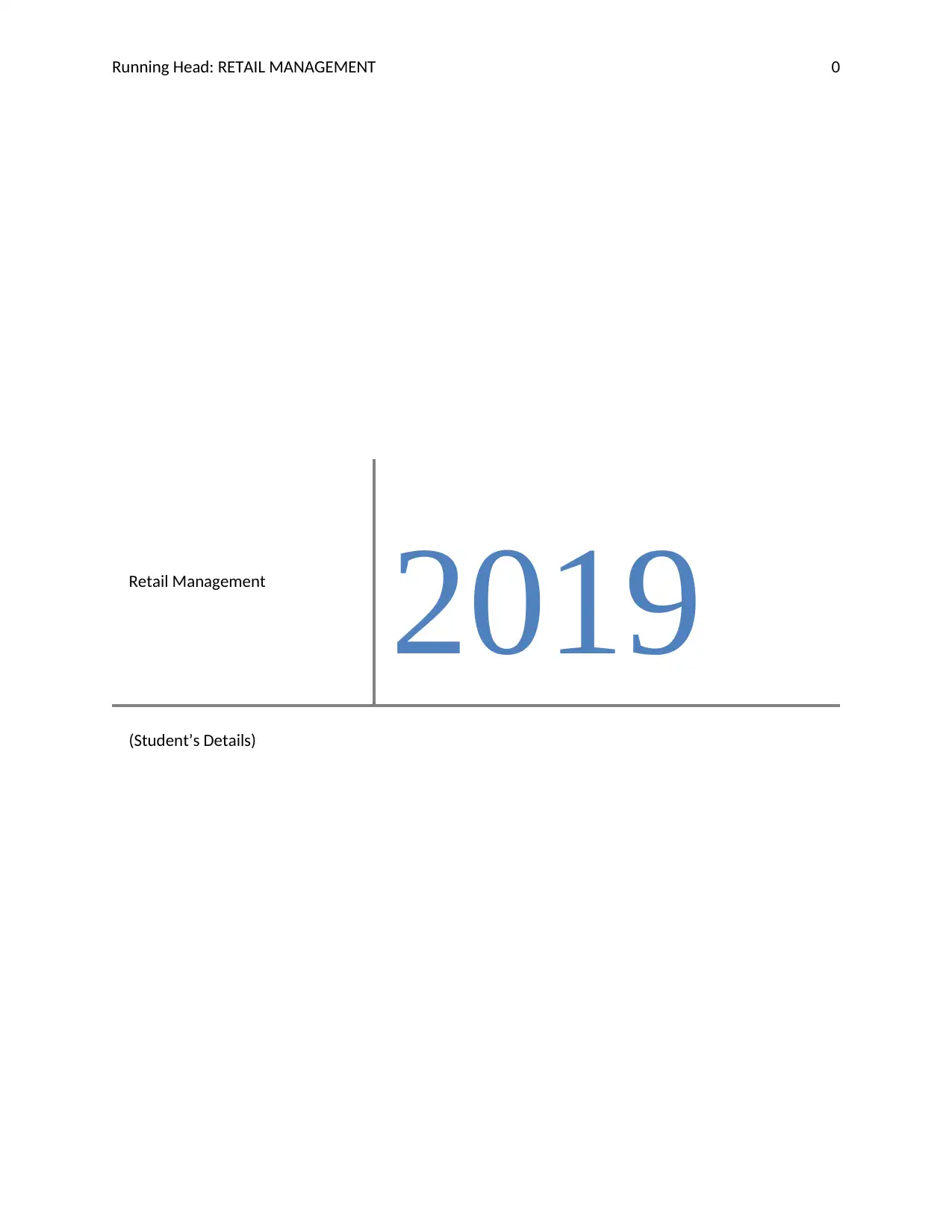
Running Head: RETAIL MANAGEMENT 0
Retail Management
2019
(Student’s Details)
Retail Management
2019
(Student’s Details)
Paraphrase This Document
Need a fresh take? Get an instant paraphrase of this document with our AI Paraphraser
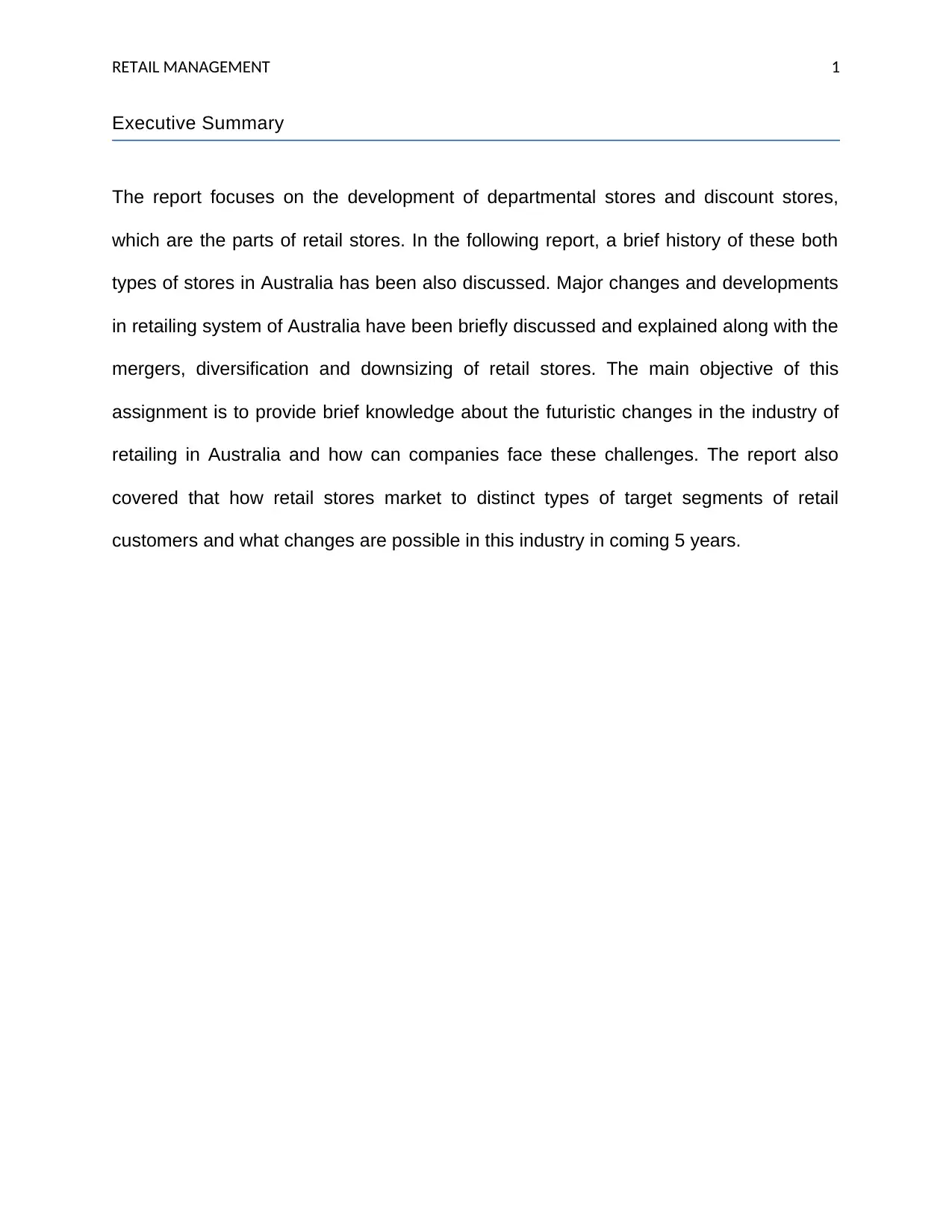
RETAIL MANAGEMENT 1
Executive Summary
The report focuses on the development of departmental stores and discount stores,
which are the parts of retail stores. In the following report, a brief history of these both
types of stores in Australia has been also discussed. Major changes and developments
in retailing system of Australia have been briefly discussed and explained along with the
mergers, diversification and downsizing of retail stores. The main objective of this
assignment is to provide brief knowledge about the futuristic changes in the industry of
retailing in Australia and how can companies face these challenges. The report also
covered that how retail stores market to distinct types of target segments of retail
customers and what changes are possible in this industry in coming 5 years.
Executive Summary
The report focuses on the development of departmental stores and discount stores,
which are the parts of retail stores. In the following report, a brief history of these both
types of stores in Australia has been also discussed. Major changes and developments
in retailing system of Australia have been briefly discussed and explained along with the
mergers, diversification and downsizing of retail stores. The main objective of this
assignment is to provide brief knowledge about the futuristic changes in the industry of
retailing in Australia and how can companies face these challenges. The report also
covered that how retail stores market to distinct types of target segments of retail
customers and what changes are possible in this industry in coming 5 years.
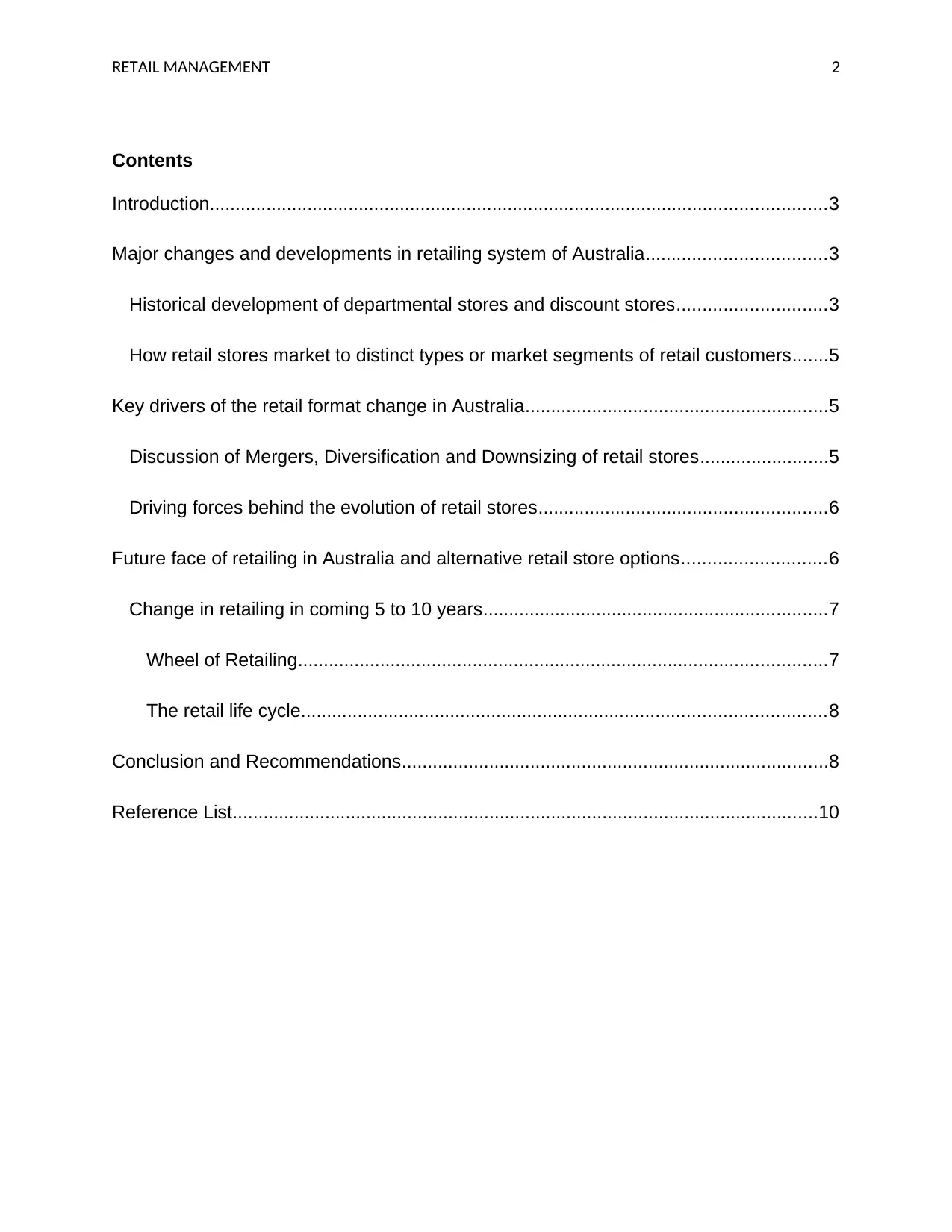
RETAIL MANAGEMENT 2
Contents
Introduction........................................................................................................................3
Major changes and developments in retailing system of Australia...................................3
Historical development of departmental stores and discount stores.............................3
How retail stores market to distinct types or market segments of retail customers.......5
Key drivers of the retail format change in Australia...........................................................5
Discussion of Mergers, Diversification and Downsizing of retail stores.........................5
Driving forces behind the evolution of retail stores........................................................6
Future face of retailing in Australia and alternative retail store options............................6
Change in retailing in coming 5 to 10 years...................................................................7
Wheel of Retailing.......................................................................................................7
The retail life cycle......................................................................................................8
Conclusion and Recommendations...................................................................................8
Reference List..................................................................................................................10
Contents
Introduction........................................................................................................................3
Major changes and developments in retailing system of Australia...................................3
Historical development of departmental stores and discount stores.............................3
How retail stores market to distinct types or market segments of retail customers.......5
Key drivers of the retail format change in Australia...........................................................5
Discussion of Mergers, Diversification and Downsizing of retail stores.........................5
Driving forces behind the evolution of retail stores........................................................6
Future face of retailing in Australia and alternative retail store options............................6
Change in retailing in coming 5 to 10 years...................................................................7
Wheel of Retailing.......................................................................................................7
The retail life cycle......................................................................................................8
Conclusion and Recommendations...................................................................................8
Reference List..................................................................................................................10
⊘ This is a preview!⊘
Do you want full access?
Subscribe today to unlock all pages.

Trusted by 1+ million students worldwide
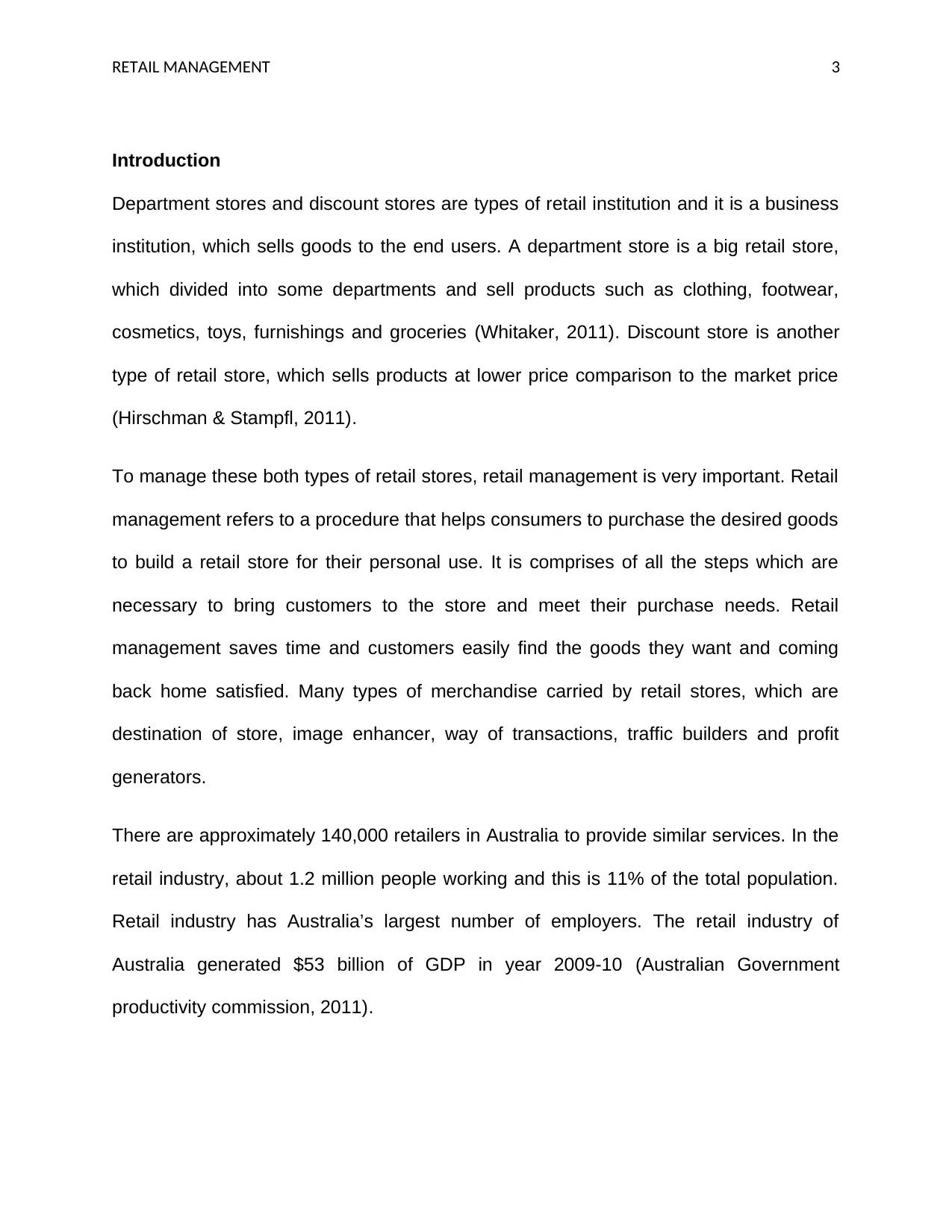
RETAIL MANAGEMENT 3
Introduction
Department stores and discount stores are types of retail institution and it is a business
institution, which sells goods to the end users. A department store is a big retail store,
which divided into some departments and sell products such as clothing, footwear,
cosmetics, toys, furnishings and groceries (Whitaker, 2011). Discount store is another
type of retail store, which sells products at lower price comparison to the market price
(Hirschman & Stampfl, 2011).
To manage these both types of retail stores, retail management is very important. Retail
management refers to a procedure that helps consumers to purchase the desired goods
to build a retail store for their personal use. It is comprises of all the steps which are
necessary to bring customers to the store and meet their purchase needs. Retail
management saves time and customers easily find the goods they want and coming
back home satisfied. Many types of merchandise carried by retail stores, which are
destination of store, image enhancer, way of transactions, traffic builders and profit
generators.
There are approximately 140,000 retailers in Australia to provide similar services. In the
retail industry, about 1.2 million people working and this is 11% of the total population.
Retail industry has Australia’s largest number of employers. The retail industry of
Australia generated $53 billion of GDP in year 2009-10 (Australian Government
productivity commission, 2011).
Introduction
Department stores and discount stores are types of retail institution and it is a business
institution, which sells goods to the end users. A department store is a big retail store,
which divided into some departments and sell products such as clothing, footwear,
cosmetics, toys, furnishings and groceries (Whitaker, 2011). Discount store is another
type of retail store, which sells products at lower price comparison to the market price
(Hirschman & Stampfl, 2011).
To manage these both types of retail stores, retail management is very important. Retail
management refers to a procedure that helps consumers to purchase the desired goods
to build a retail store for their personal use. It is comprises of all the steps which are
necessary to bring customers to the store and meet their purchase needs. Retail
management saves time and customers easily find the goods they want and coming
back home satisfied. Many types of merchandise carried by retail stores, which are
destination of store, image enhancer, way of transactions, traffic builders and profit
generators.
There are approximately 140,000 retailers in Australia to provide similar services. In the
retail industry, about 1.2 million people working and this is 11% of the total population.
Retail industry has Australia’s largest number of employers. The retail industry of
Australia generated $53 billion of GDP in year 2009-10 (Australian Government
productivity commission, 2011).
Paraphrase This Document
Need a fresh take? Get an instant paraphrase of this document with our AI Paraphraser
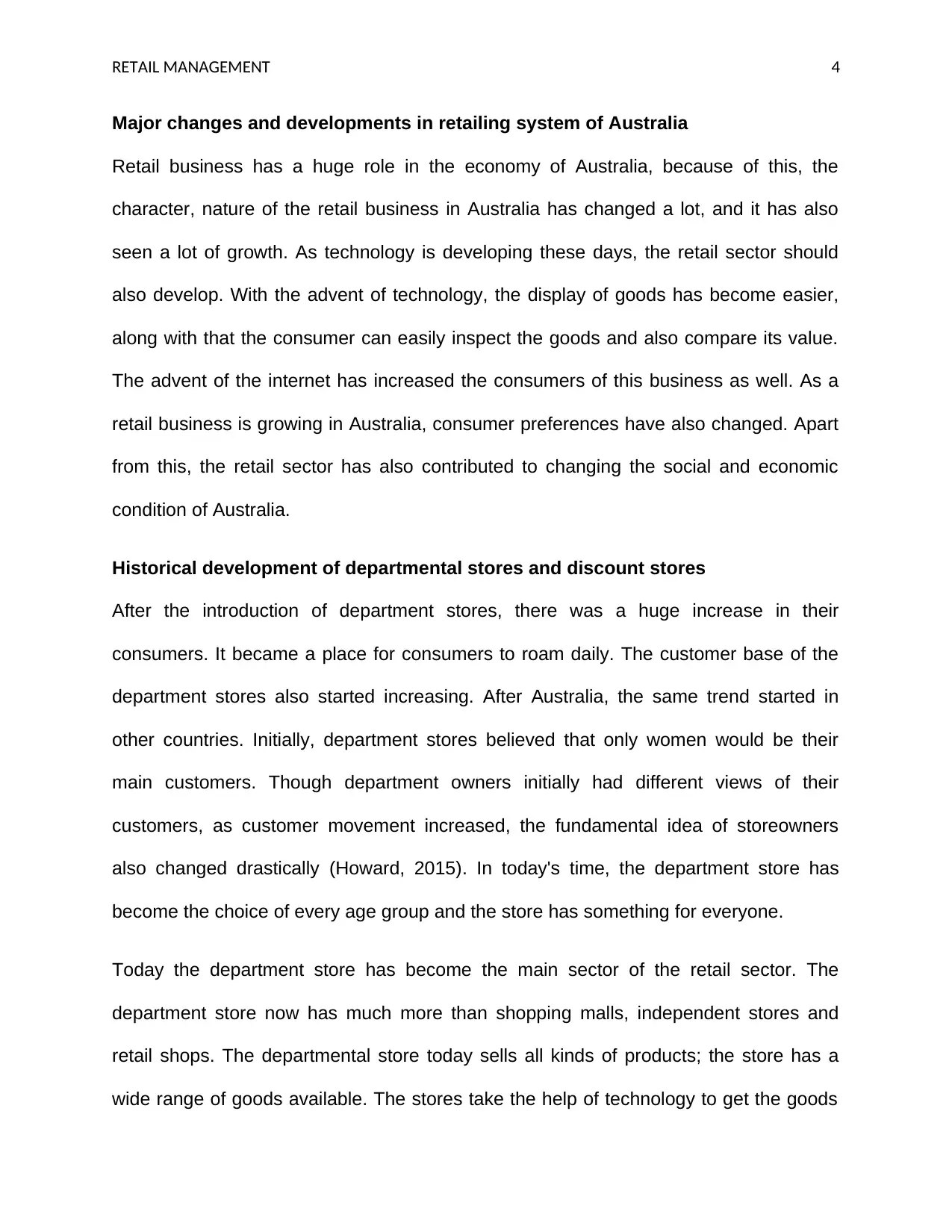
RETAIL MANAGEMENT 4
Major changes and developments in retailing system of Australia
Retail business has a huge role in the economy of Australia, because of this, the
character, nature of the retail business in Australia has changed a lot, and it has also
seen a lot of growth. As technology is developing these days, the retail sector should
also develop. With the advent of technology, the display of goods has become easier,
along with that the consumer can easily inspect the goods and also compare its value.
The advent of the internet has increased the consumers of this business as well. As a
retail business is growing in Australia, consumer preferences have also changed. Apart
from this, the retail sector has also contributed to changing the social and economic
condition of Australia.
Historical development of departmental stores and discount stores
After the introduction of department stores, there was a huge increase in their
consumers. It became a place for consumers to roam daily. The customer base of the
department stores also started increasing. After Australia, the same trend started in
other countries. Initially, department stores believed that only women would be their
main customers. Though department owners initially had different views of their
customers, as customer movement increased, the fundamental idea of storeowners
also changed drastically (Howard, 2015). In today's time, the department store has
become the choice of every age group and the store has something for everyone.
Today the department store has become the main sector of the retail sector. The
department store now has much more than shopping malls, independent stores and
retail shops. The departmental store today sells all kinds of products; the store has a
wide range of goods available. The stores take the help of technology to get the goods
Major changes and developments in retailing system of Australia
Retail business has a huge role in the economy of Australia, because of this, the
character, nature of the retail business in Australia has changed a lot, and it has also
seen a lot of growth. As technology is developing these days, the retail sector should
also develop. With the advent of technology, the display of goods has become easier,
along with that the consumer can easily inspect the goods and also compare its value.
The advent of the internet has increased the consumers of this business as well. As a
retail business is growing in Australia, consumer preferences have also changed. Apart
from this, the retail sector has also contributed to changing the social and economic
condition of Australia.
Historical development of departmental stores and discount stores
After the introduction of department stores, there was a huge increase in their
consumers. It became a place for consumers to roam daily. The customer base of the
department stores also started increasing. After Australia, the same trend started in
other countries. Initially, department stores believed that only women would be their
main customers. Though department owners initially had different views of their
customers, as customer movement increased, the fundamental idea of storeowners
also changed drastically (Howard, 2015). In today's time, the department store has
become the choice of every age group and the store has something for everyone.
Today the department store has become the main sector of the retail sector. The
department store now has much more than shopping malls, independent stores and
retail shops. The departmental store today sells all kinds of products; the store has a
wide range of goods available. The stores take the help of technology to get the goods
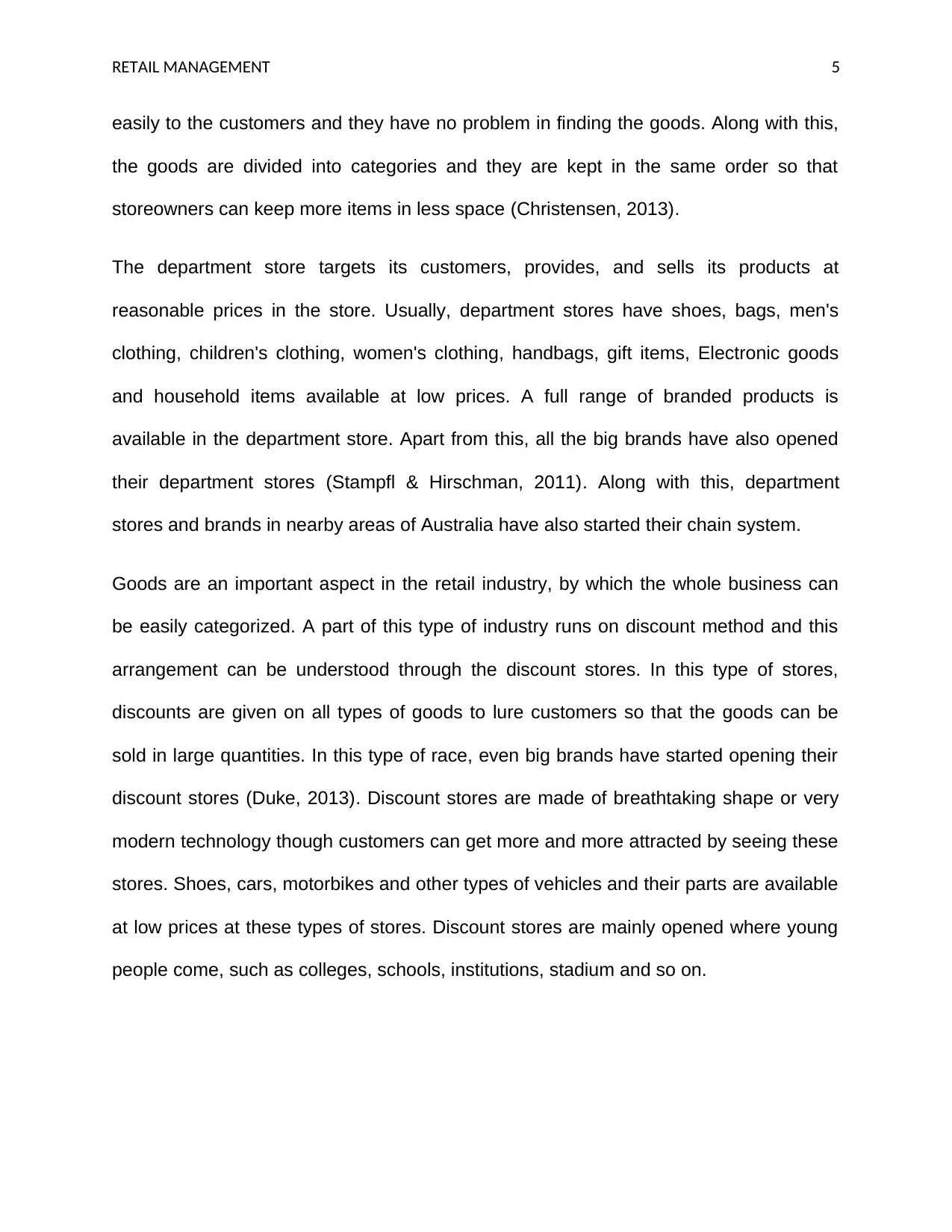
RETAIL MANAGEMENT 5
easily to the customers and they have no problem in finding the goods. Along with this,
the goods are divided into categories and they are kept in the same order so that
storeowners can keep more items in less space (Christensen, 2013).
The department store targets its customers, provides, and sells its products at
reasonable prices in the store. Usually, department stores have shoes, bags, men's
clothing, children's clothing, women's clothing, handbags, gift items, Electronic goods
and household items available at low prices. A full range of branded products is
available in the department store. Apart from this, all the big brands have also opened
their department stores (Stampfl & Hirschman, 2011). Along with this, department
stores and brands in nearby areas of Australia have also started their chain system.
Goods are an important aspect in the retail industry, by which the whole business can
be easily categorized. A part of this type of industry runs on discount method and this
arrangement can be understood through the discount stores. In this type of stores,
discounts are given on all types of goods to lure customers so that the goods can be
sold in large quantities. In this type of race, even big brands have started opening their
discount stores (Duke, 2013). Discount stores are made of breathtaking shape or very
modern technology though customers can get more and more attracted by seeing these
stores. Shoes, cars, motorbikes and other types of vehicles and their parts are available
at low prices at these types of stores. Discount stores are mainly opened where young
people come, such as colleges, schools, institutions, stadium and so on.
easily to the customers and they have no problem in finding the goods. Along with this,
the goods are divided into categories and they are kept in the same order so that
storeowners can keep more items in less space (Christensen, 2013).
The department store targets its customers, provides, and sells its products at
reasonable prices in the store. Usually, department stores have shoes, bags, men's
clothing, children's clothing, women's clothing, handbags, gift items, Electronic goods
and household items available at low prices. A full range of branded products is
available in the department store. Apart from this, all the big brands have also opened
their department stores (Stampfl & Hirschman, 2011). Along with this, department
stores and brands in nearby areas of Australia have also started their chain system.
Goods are an important aspect in the retail industry, by which the whole business can
be easily categorized. A part of this type of industry runs on discount method and this
arrangement can be understood through the discount stores. In this type of stores,
discounts are given on all types of goods to lure customers so that the goods can be
sold in large quantities. In this type of race, even big brands have started opening their
discount stores (Duke, 2013). Discount stores are made of breathtaking shape or very
modern technology though customers can get more and more attracted by seeing these
stores. Shoes, cars, motorbikes and other types of vehicles and their parts are available
at low prices at these types of stores. Discount stores are mainly opened where young
people come, such as colleges, schools, institutions, stadium and so on.
⊘ This is a preview!⊘
Do you want full access?
Subscribe today to unlock all pages.

Trusted by 1+ million students worldwide
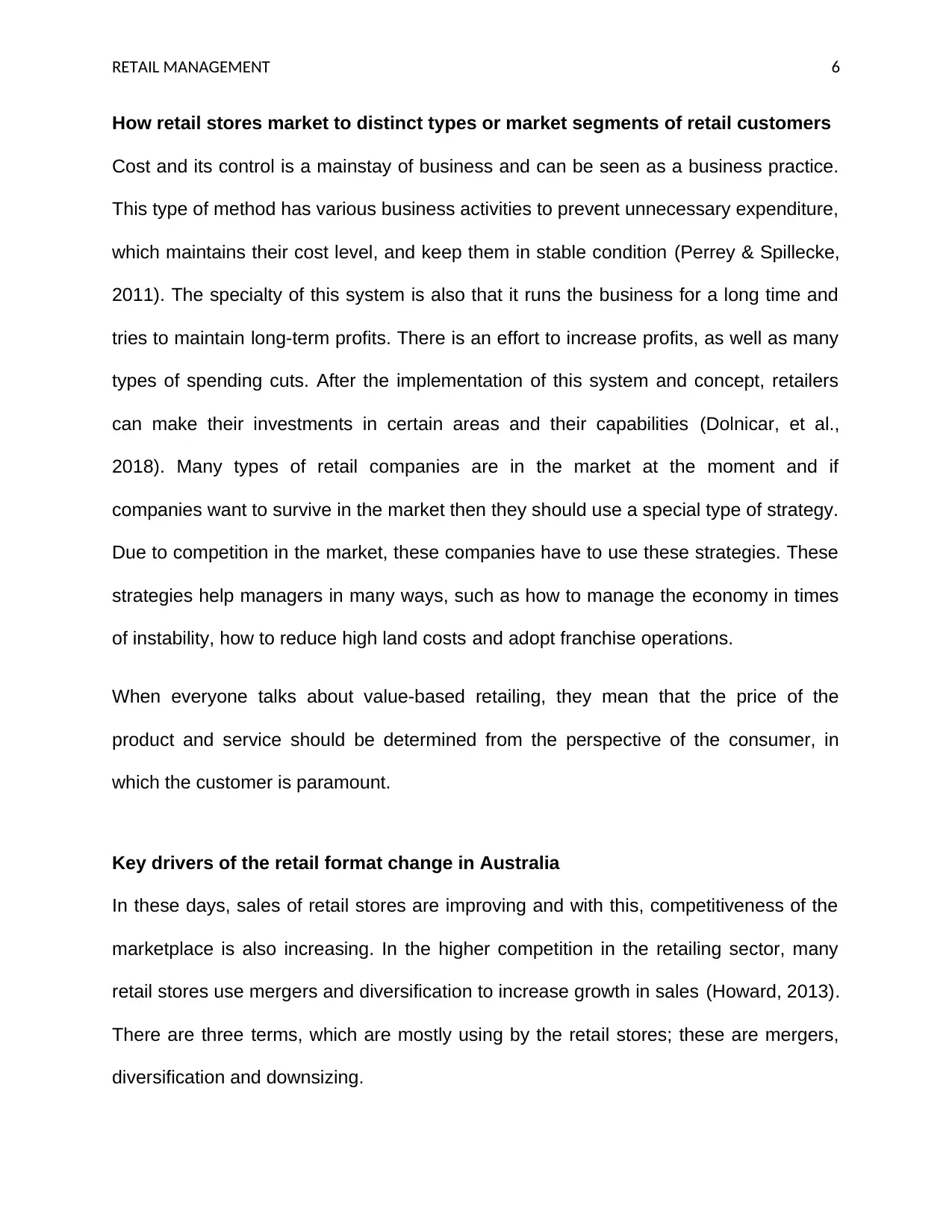
RETAIL MANAGEMENT 6
How retail stores market to distinct types or market segments of retail customers
Cost and its control is a mainstay of business and can be seen as a business practice.
This type of method has various business activities to prevent unnecessary expenditure,
which maintains their cost level, and keep them in stable condition (Perrey & Spillecke,
2011). The specialty of this system is also that it runs the business for a long time and
tries to maintain long-term profits. There is an effort to increase profits, as well as many
types of spending cuts. After the implementation of this system and concept, retailers
can make their investments in certain areas and their capabilities (Dolnicar, et al.,
2018). Many types of retail companies are in the market at the moment and if
companies want to survive in the market then they should use a special type of strategy.
Due to competition in the market, these companies have to use these strategies. These
strategies help managers in many ways, such as how to manage the economy in times
of instability, how to reduce high land costs and adopt franchise operations.
When everyone talks about value-based retailing, they mean that the price of the
product and service should be determined from the perspective of the consumer, in
which the customer is paramount.
Key drivers of the retail format change in Australia
In these days, sales of retail stores are improving and with this, competitiveness of the
marketplace is also increasing. In the higher competition in the retailing sector, many
retail stores use mergers and diversification to increase growth in sales (Howard, 2013).
There are three terms, which are mostly using by the retail stores; these are mergers,
diversification and downsizing.
How retail stores market to distinct types or market segments of retail customers
Cost and its control is a mainstay of business and can be seen as a business practice.
This type of method has various business activities to prevent unnecessary expenditure,
which maintains their cost level, and keep them in stable condition (Perrey & Spillecke,
2011). The specialty of this system is also that it runs the business for a long time and
tries to maintain long-term profits. There is an effort to increase profits, as well as many
types of spending cuts. After the implementation of this system and concept, retailers
can make their investments in certain areas and their capabilities (Dolnicar, et al.,
2018). Many types of retail companies are in the market at the moment and if
companies want to survive in the market then they should use a special type of strategy.
Due to competition in the market, these companies have to use these strategies. These
strategies help managers in many ways, such as how to manage the economy in times
of instability, how to reduce high land costs and adopt franchise operations.
When everyone talks about value-based retailing, they mean that the price of the
product and service should be determined from the perspective of the consumer, in
which the customer is paramount.
Key drivers of the retail format change in Australia
In these days, sales of retail stores are improving and with this, competitiveness of the
marketplace is also increasing. In the higher competition in the retailing sector, many
retail stores use mergers and diversification to increase growth in sales (Howard, 2013).
There are three terms, which are mostly using by the retail stores; these are mergers,
diversification and downsizing.
Paraphrase This Document
Need a fresh take? Get an instant paraphrase of this document with our AI Paraphraser
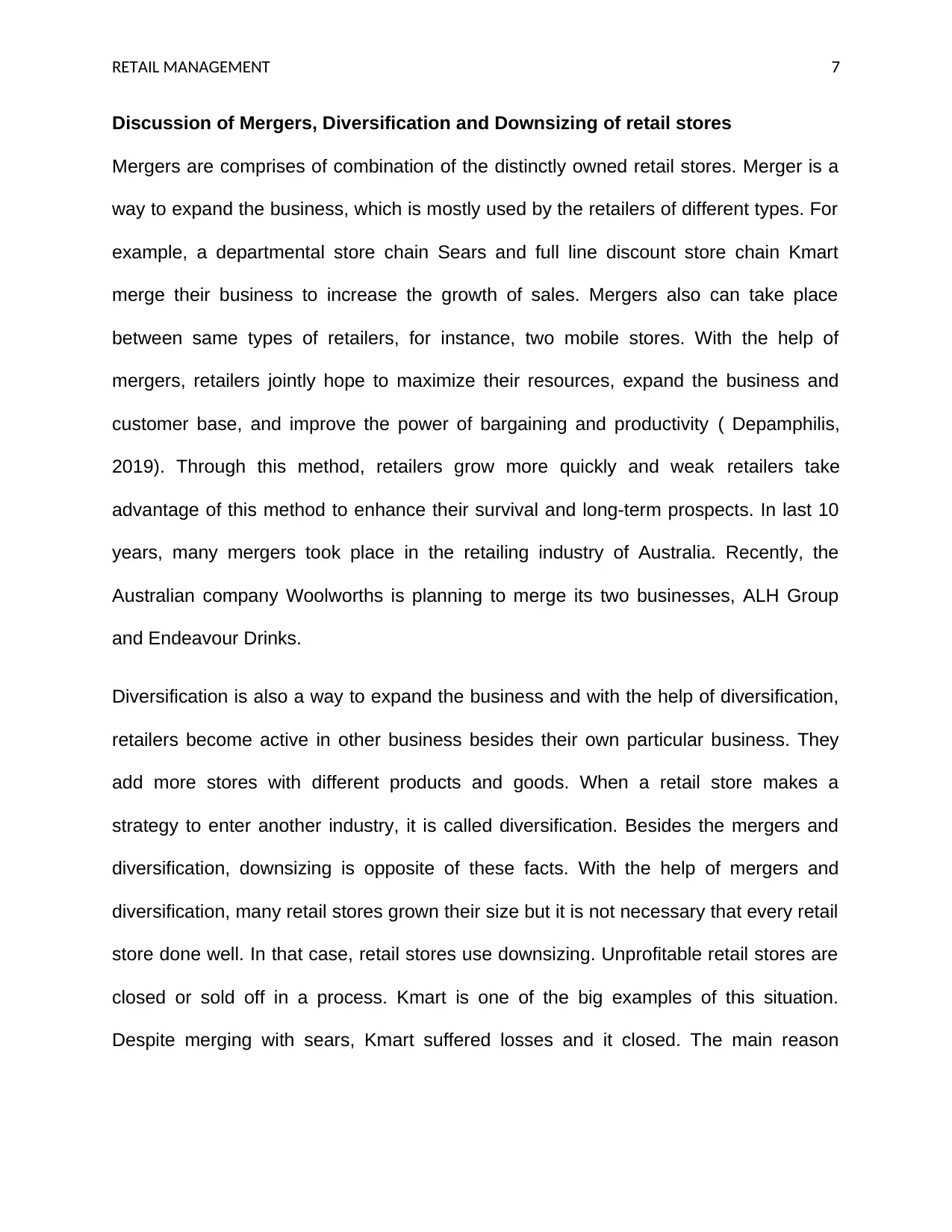
RETAIL MANAGEMENT 7
Discussion of Mergers, Diversification and Downsizing of retail stores
Mergers are comprises of combination of the distinctly owned retail stores. Merger is a
way to expand the business, which is mostly used by the retailers of different types. For
example, a departmental store chain Sears and full line discount store chain Kmart
merge their business to increase the growth of sales. Mergers also can take place
between same types of retailers, for instance, two mobile stores. With the help of
mergers, retailers jointly hope to maximize their resources, expand the business and
customer base, and improve the power of bargaining and productivity ( Depamphilis,
2019). Through this method, retailers grow more quickly and weak retailers take
advantage of this method to enhance their survival and long-term prospects. In last 10
years, many mergers took place in the retailing industry of Australia. Recently, the
Australian company Woolworths is planning to merge its two businesses, ALH Group
and Endeavour Drinks.
Diversification is also a way to expand the business and with the help of diversification,
retailers become active in other business besides their own particular business. They
add more stores with different products and goods. When a retail store makes a
strategy to enter another industry, it is called diversification. Besides the mergers and
diversification, downsizing is opposite of these facts. With the help of mergers and
diversification, many retail stores grown their size but it is not necessary that every retail
store done well. In that case, retail stores use downsizing. Unprofitable retail stores are
closed or sold off in a process. Kmart is one of the big examples of this situation.
Despite merging with sears, Kmart suffered losses and it closed. The main reason
Discussion of Mergers, Diversification and Downsizing of retail stores
Mergers are comprises of combination of the distinctly owned retail stores. Merger is a
way to expand the business, which is mostly used by the retailers of different types. For
example, a departmental store chain Sears and full line discount store chain Kmart
merge their business to increase the growth of sales. Mergers also can take place
between same types of retailers, for instance, two mobile stores. With the help of
mergers, retailers jointly hope to maximize their resources, expand the business and
customer base, and improve the power of bargaining and productivity ( Depamphilis,
2019). Through this method, retailers grow more quickly and weak retailers take
advantage of this method to enhance their survival and long-term prospects. In last 10
years, many mergers took place in the retailing industry of Australia. Recently, the
Australian company Woolworths is planning to merge its two businesses, ALH Group
and Endeavour Drinks.
Diversification is also a way to expand the business and with the help of diversification,
retailers become active in other business besides their own particular business. They
add more stores with different products and goods. When a retail store makes a
strategy to enter another industry, it is called diversification. Besides the mergers and
diversification, downsizing is opposite of these facts. With the help of mergers and
diversification, many retail stores grown their size but it is not necessary that every retail
store done well. In that case, retail stores use downsizing. Unprofitable retail stores are
closed or sold off in a process. Kmart is one of the big examples of this situation.
Despite merging with sears, Kmart suffered losses and it closed. The main reason
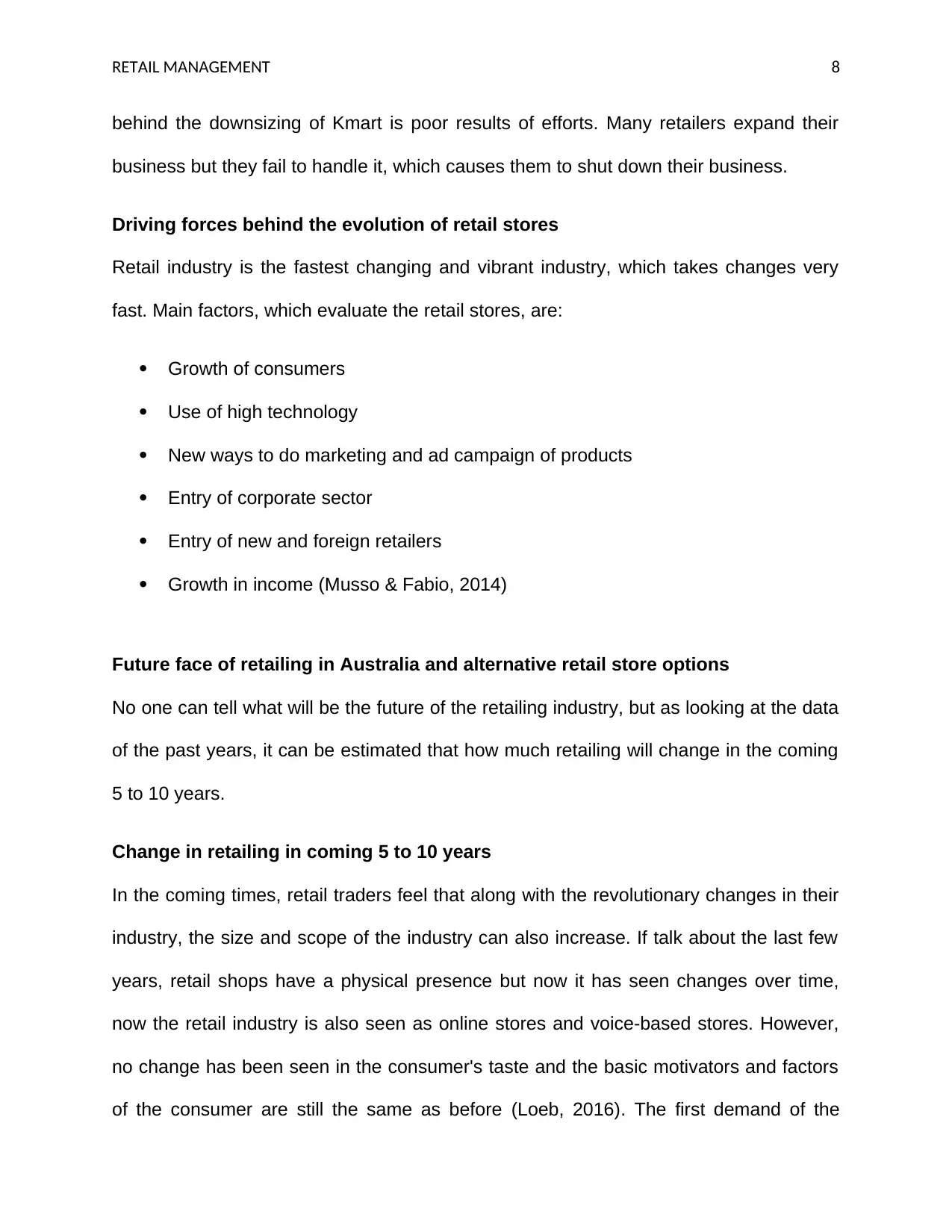
RETAIL MANAGEMENT 8
behind the downsizing of Kmart is poor results of efforts. Many retailers expand their
business but they fail to handle it, which causes them to shut down their business.
Driving forces behind the evolution of retail stores
Retail industry is the fastest changing and vibrant industry, which takes changes very
fast. Main factors, which evaluate the retail stores, are:
Growth of consumers
Use of high technology
New ways to do marketing and ad campaign of products
Entry of corporate sector
Entry of new and foreign retailers
Growth in income (Musso & Fabio, 2014)
Future face of retailing in Australia and alternative retail store options
No one can tell what will be the future of the retailing industry, but as looking at the data
of the past years, it can be estimated that how much retailing will change in the coming
5 to 10 years.
Change in retailing in coming 5 to 10 years
In the coming times, retail traders feel that along with the revolutionary changes in their
industry, the size and scope of the industry can also increase. If talk about the last few
years, retail shops have a physical presence but now it has seen changes over time,
now the retail industry is also seen as online stores and voice-based stores. However,
no change has been seen in the consumer's taste and the basic motivators and factors
of the consumer are still the same as before (Loeb, 2016). The first demand of the
behind the downsizing of Kmart is poor results of efforts. Many retailers expand their
business but they fail to handle it, which causes them to shut down their business.
Driving forces behind the evolution of retail stores
Retail industry is the fastest changing and vibrant industry, which takes changes very
fast. Main factors, which evaluate the retail stores, are:
Growth of consumers
Use of high technology
New ways to do marketing and ad campaign of products
Entry of corporate sector
Entry of new and foreign retailers
Growth in income (Musso & Fabio, 2014)
Future face of retailing in Australia and alternative retail store options
No one can tell what will be the future of the retailing industry, but as looking at the data
of the past years, it can be estimated that how much retailing will change in the coming
5 to 10 years.
Change in retailing in coming 5 to 10 years
In the coming times, retail traders feel that along with the revolutionary changes in their
industry, the size and scope of the industry can also increase. If talk about the last few
years, retail shops have a physical presence but now it has seen changes over time,
now the retail industry is also seen as online stores and voice-based stores. However,
no change has been seen in the consumer's taste and the basic motivators and factors
of the consumer are still the same as before (Loeb, 2016). The first demand of the
⊘ This is a preview!⊘
Do you want full access?
Subscribe today to unlock all pages.

Trusted by 1+ million students worldwide
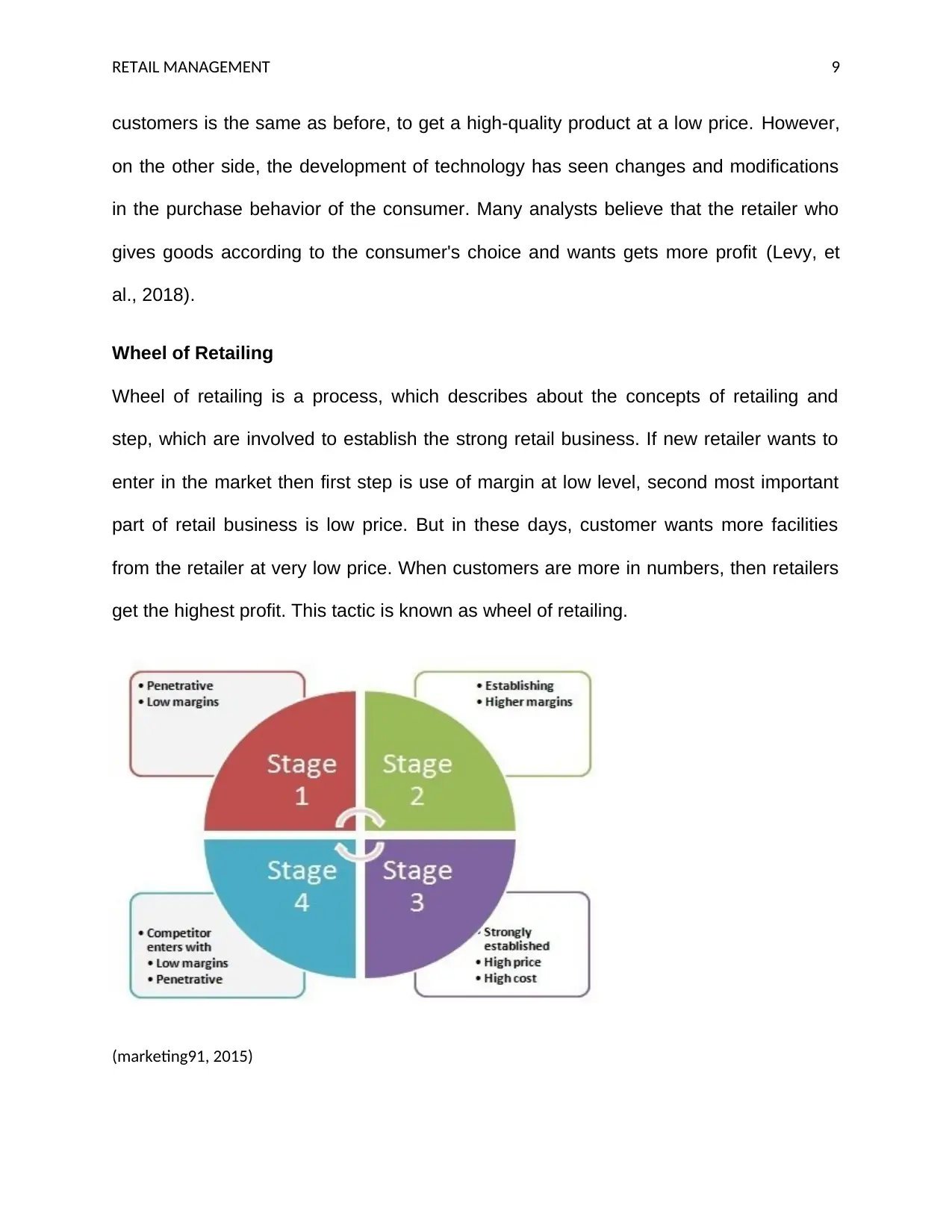
RETAIL MANAGEMENT 9
customers is the same as before, to get a high-quality product at a low price. However,
on the other side, the development of technology has seen changes and modifications
in the purchase behavior of the consumer. Many analysts believe that the retailer who
gives goods according to the consumer's choice and wants gets more profit (Levy, et
al., 2018).
Wheel of Retailing
Wheel of retailing is a process, which describes about the concepts of retailing and
step, which are involved to establish the strong retail business. If new retailer wants to
enter in the market then first step is use of margin at low level, second most important
part of retail business is low price. But in these days, customer wants more facilities
from the retailer at very low price. When customers are more in numbers, then retailers
get the highest profit. This tactic is known as wheel of retailing.
(marketing91, 2015)
customers is the same as before, to get a high-quality product at a low price. However,
on the other side, the development of technology has seen changes and modifications
in the purchase behavior of the consumer. Many analysts believe that the retailer who
gives goods according to the consumer's choice and wants gets more profit (Levy, et
al., 2018).
Wheel of Retailing
Wheel of retailing is a process, which describes about the concepts of retailing and
step, which are involved to establish the strong retail business. If new retailer wants to
enter in the market then first step is use of margin at low level, second most important
part of retail business is low price. But in these days, customer wants more facilities
from the retailer at very low price. When customers are more in numbers, then retailers
get the highest profit. This tactic is known as wheel of retailing.
(marketing91, 2015)
Paraphrase This Document
Need a fresh take? Get an instant paraphrase of this document with our AI Paraphraser
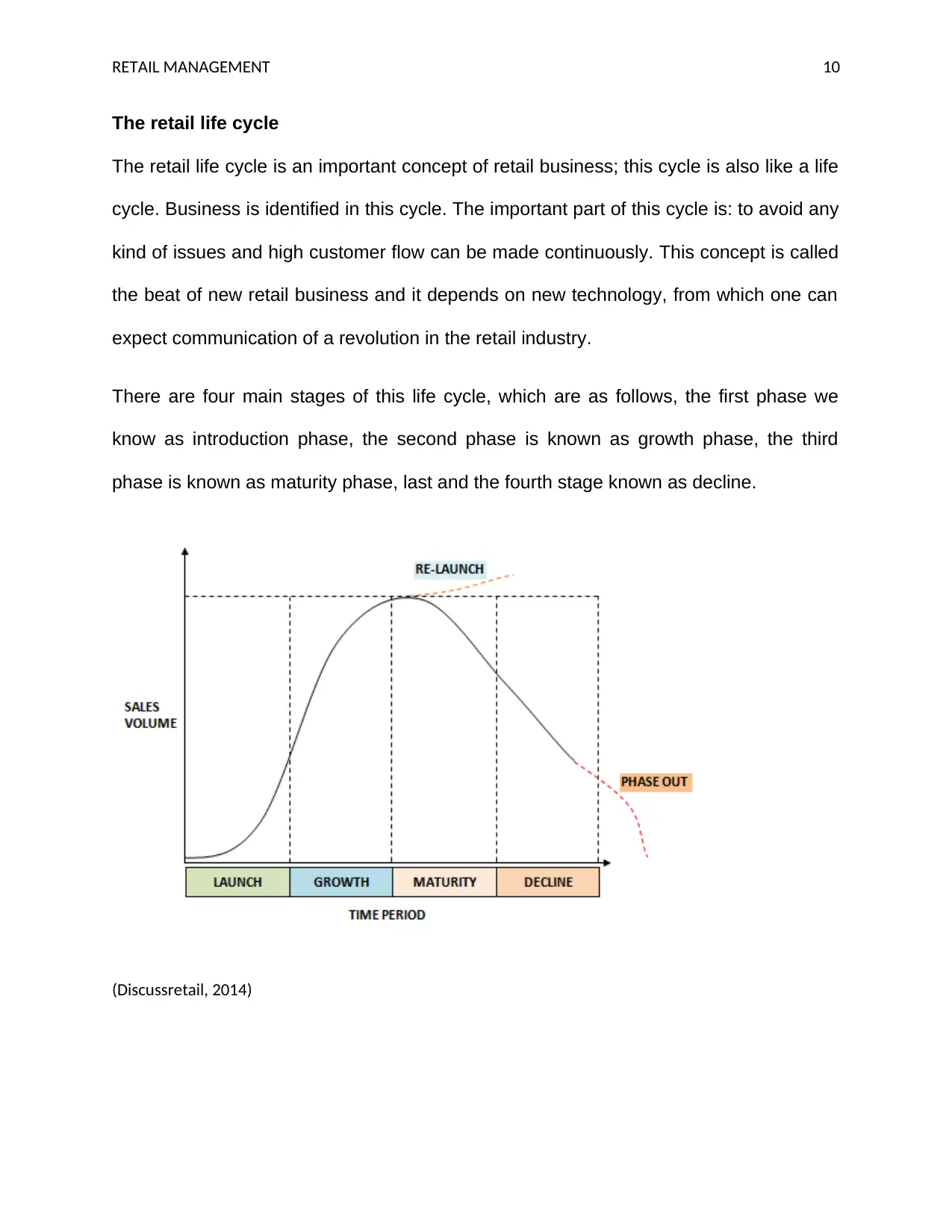
RETAIL MANAGEMENT 10
The retail life cycle
The retail life cycle is an important concept of retail business; this cycle is also like a life
cycle. Business is identified in this cycle. The important part of this cycle is: to avoid any
kind of issues and high customer flow can be made continuously. This concept is called
the beat of new retail business and it depends on new technology, from which one can
expect communication of a revolution in the retail industry.
There are four main stages of this life cycle, which are as follows, the first phase we
know as introduction phase, the second phase is known as growth phase, the third
phase is known as maturity phase, last and the fourth stage known as decline.
(Discussretail, 2014)
The retail life cycle
The retail life cycle is an important concept of retail business; this cycle is also like a life
cycle. Business is identified in this cycle. The important part of this cycle is: to avoid any
kind of issues and high customer flow can be made continuously. This concept is called
the beat of new retail business and it depends on new technology, from which one can
expect communication of a revolution in the retail industry.
There are four main stages of this life cycle, which are as follows, the first phase we
know as introduction phase, the second phase is known as growth phase, the third
phase is known as maturity phase, last and the fourth stage known as decline.
(Discussretail, 2014)
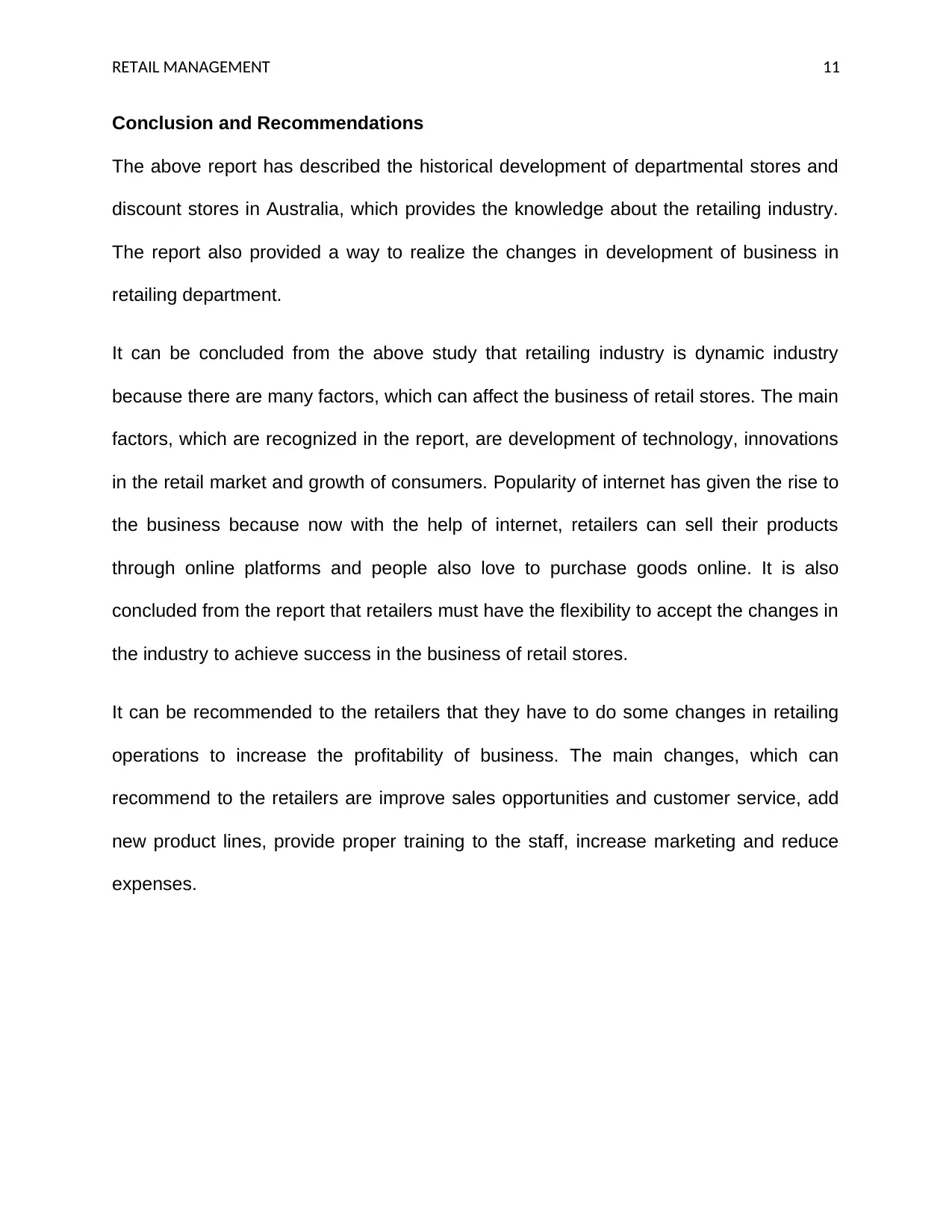
RETAIL MANAGEMENT 11
Conclusion and Recommendations
The above report has described the historical development of departmental stores and
discount stores in Australia, which provides the knowledge about the retailing industry.
The report also provided a way to realize the changes in development of business in
retailing department.
It can be concluded from the above study that retailing industry is dynamic industry
because there are many factors, which can affect the business of retail stores. The main
factors, which are recognized in the report, are development of technology, innovations
in the retail market and growth of consumers. Popularity of internet has given the rise to
the business because now with the help of internet, retailers can sell their products
through online platforms and people also love to purchase goods online. It is also
concluded from the report that retailers must have the flexibility to accept the changes in
the industry to achieve success in the business of retail stores.
It can be recommended to the retailers that they have to do some changes in retailing
operations to increase the profitability of business. The main changes, which can
recommend to the retailers are improve sales opportunities and customer service, add
new product lines, provide proper training to the staff, increase marketing and reduce
expenses.
Conclusion and Recommendations
The above report has described the historical development of departmental stores and
discount stores in Australia, which provides the knowledge about the retailing industry.
The report also provided a way to realize the changes in development of business in
retailing department.
It can be concluded from the above study that retailing industry is dynamic industry
because there are many factors, which can affect the business of retail stores. The main
factors, which are recognized in the report, are development of technology, innovations
in the retail market and growth of consumers. Popularity of internet has given the rise to
the business because now with the help of internet, retailers can sell their products
through online platforms and people also love to purchase goods online. It is also
concluded from the report that retailers must have the flexibility to accept the changes in
the industry to achieve success in the business of retail stores.
It can be recommended to the retailers that they have to do some changes in retailing
operations to increase the profitability of business. The main changes, which can
recommend to the retailers are improve sales opportunities and customer service, add
new product lines, provide proper training to the staff, increase marketing and reduce
expenses.
⊘ This is a preview!⊘
Do you want full access?
Subscribe today to unlock all pages.

Trusted by 1+ million students worldwide
1 out of 14
Related Documents
Your All-in-One AI-Powered Toolkit for Academic Success.
+13062052269
info@desklib.com
Available 24*7 on WhatsApp / Email
![[object Object]](/_next/static/media/star-bottom.7253800d.svg)
Unlock your academic potential
Copyright © 2020–2025 A2Z Services. All Rights Reserved. Developed and managed by ZUCOL.




